10 Inspiring Vertical Garden Ideas for Small Spaces
Living in a small space doesn’t have to limit your love for plants. Envision turning bare walls, tiny balconies, or even corners in your home into lush, thriving gardens. Vertical gardening offers a creative way to bring greenery into compact areas, making the most of every inch. Explore these ten inspiring vertical garden ideas that can transform your small space into a green sanctuary.
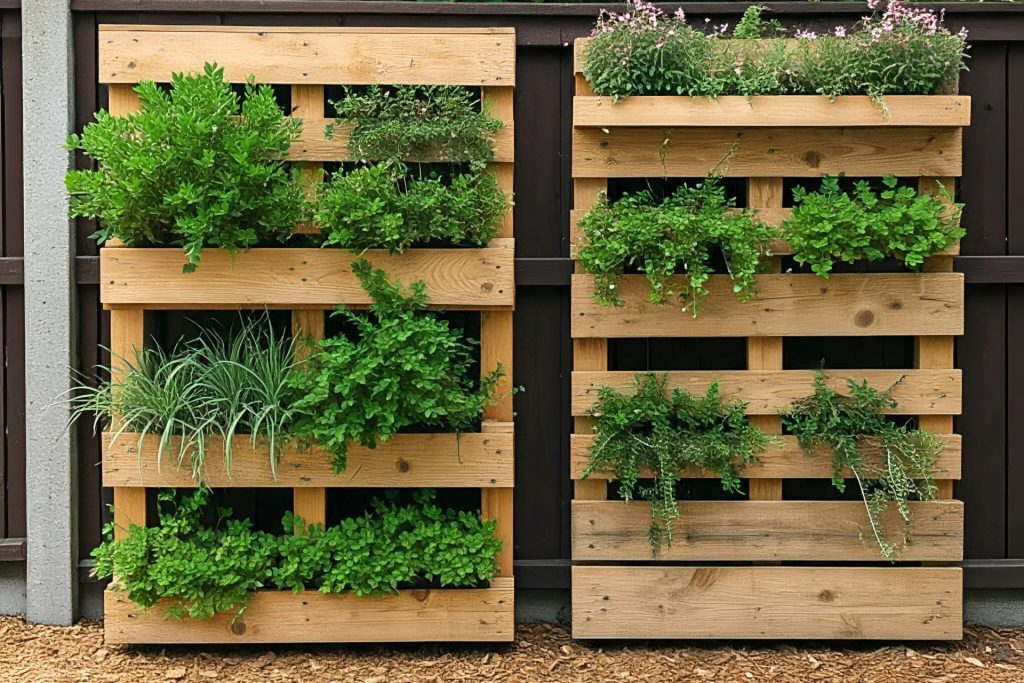
Embracing Vertical Gardening in Small Spaces
Small living spaces often present challenges for plant lovers. Vertical gardening offers an innovative solution by allowing plants to grow upwards, maximizing the use of limited space. This method transforms unused walls and narrow areas into vibrant gardens, making it ideal for apartments, balconies, and compact yards. Vertical gardens not only save space but also enhance aesthetics and improve air quality. They bring nature closer, creating a soothing environment even in the heart of a city.
Idea 1: Wall-Mounted Planters and Pockets
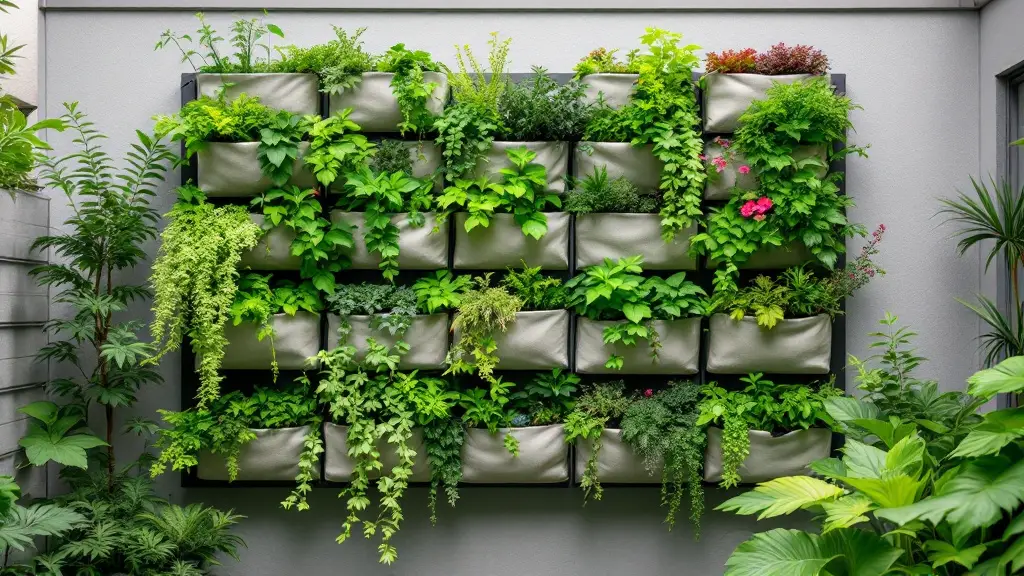
Utilizing Wall-Mounted Planters or Fabric Pockets
Wall-mounted planters and fabric pockets offer a simple way to create a vertical garden. They attach directly to walls, fences, or balcony railings, turning blank surfaces into lively displays. These planters come in various materials like wood, metal, or durable fabric, and they suit both indoor and outdoor settings. By using wall space, they free up the floor area, making them perfect for small apartments or patios.
Benefits for Small Spaces
Using vertical surfaces allows you to have more plants without crowding your living space. Wall-mounted planters add greenery to eye level, enhancing the visual appeal of your home. They also make gardening accessible, even in the tightest spots.
DIY Tips and Product Recommendations
DIY Tips:
- Choose planters that match the wall material and can support the weight of soil and plants.
- Install planters using appropriate hardware, ensuring they are secure.
- Protect indoor walls by using waterproof backing or liners to prevent moisture damage.
Product Recommendations:
- Felt pocket planters with multiple compartments.
- Modular wall planters with built-in irrigation systems for easy maintenance.
Plant Suggestions
- Herbs: Basil, mint, and parsley thrive in wall planters and are handy for cooking.
- Flowers: Petunias and pansies add color and fragrance.
- Succulents: For low-maintenance options, consider varieties like sedum or echeveria.
Idea 2: Hanging Herb Garden in the Kitchen
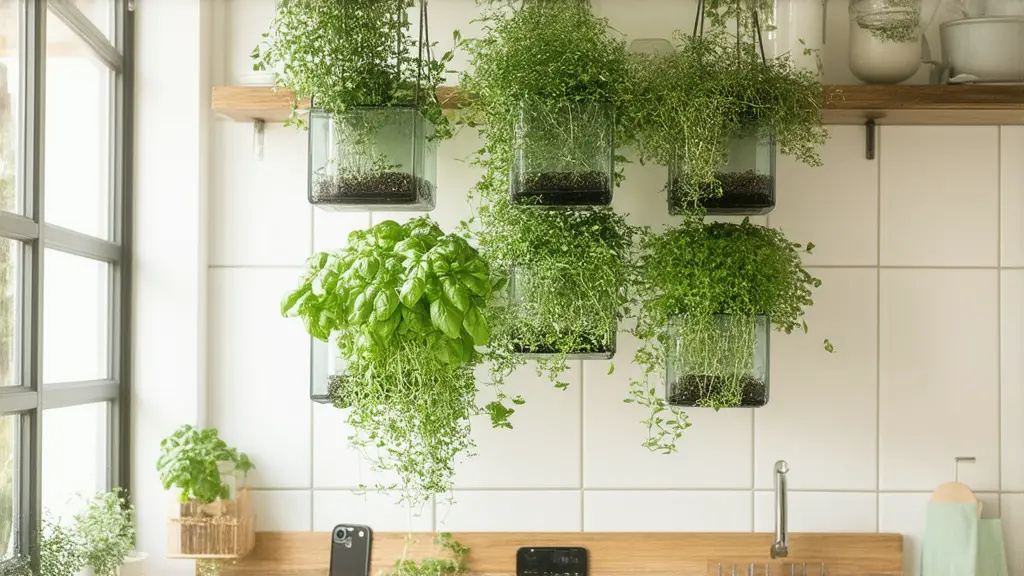
Utilizing Hanging Planters
Creating a hanging herb garden in the kitchen brings fresh flavors right to your fingertips. By suspending planters from the ceiling or beneath shelves, you make use of overhead space that often goes unused. Small pots, mason jars, or specialized hanging planters can hold a variety of herbs, adding both function and charm to your cooking area.
Growing Fresh Herbs
Having fresh herbs like thyme, oregano, or cilantro within reach enhances your culinary creations. The pleasant aromas also add a sensory delight to your kitchen. Growing herbs indoors ensures a year-round supply, regardless of the weather outside.
Space-Saving Benefits
Hanging planters keep your countertops clear, essential in a small kitchen. They add vertical interest and can become a decorative focal point. Utilizing the space above your head maximizes your gardening potential without sacrificing room.
Installation Tips
- Ensure that ceiling fixtures are secure and can bear the weight of the planters.
- Use adjustable hangers or pulley systems to make watering and harvesting easier.
- Consider the light needs of your herbs and place them near a window or provide artificial grow lights.
Idea 3: DIY Pallet Vertical Garden

Upcycling Wooden Pallets
Turning a wooden pallet into a vertical garden is an eco-friendly and budget-friendly project. By repurposing pallets, you create a rustic and attractive planter that can stand against a wall or be mounted securely. This method is ideal for outdoor spaces like balconies or patios.
Steps to Create a Pallet Garden
- Preparation:
- Select a clean, sturdy pallet without harmful chemicals.
- Sand the wood to remove splinters and rough edges.
- Apply a wood sealant or paint to protect it from the elements.
- Adding Backing and Lining:
- Attach landscape fabric or plastic sheeting to the back, bottom, and sides of the pallet to hold soil.
- Secure the lining with a staple gun or nails.
- Planting:
- Lay the pallet flat on the ground.
- Fill it with a lightweight potting mix, pressing soil into each slat.
- Plant your chosen seedlings in the gaps between slats.
- Mounting:
- Allow the plants to root for a couple of weeks before standing the pallet upright.
- Secure the pallet against a wall or fence, ensuring it is stable.
Suitable Plants
- Hardy Plants: Ferns, ivy, and small flowering plants like marigolds work well.
- Herbs and Greens: Lettuce, spinach, and herbs can thrive in this setup.
Maintenance Tips
- Water the pallet garden carefully to prevent soil erosion.
- Monitor the wood for signs of rot, and reapply sealant as needed.
- Check for pests and address any issues promptly.
Idea 4: Shoe Organizer Vertical Garden
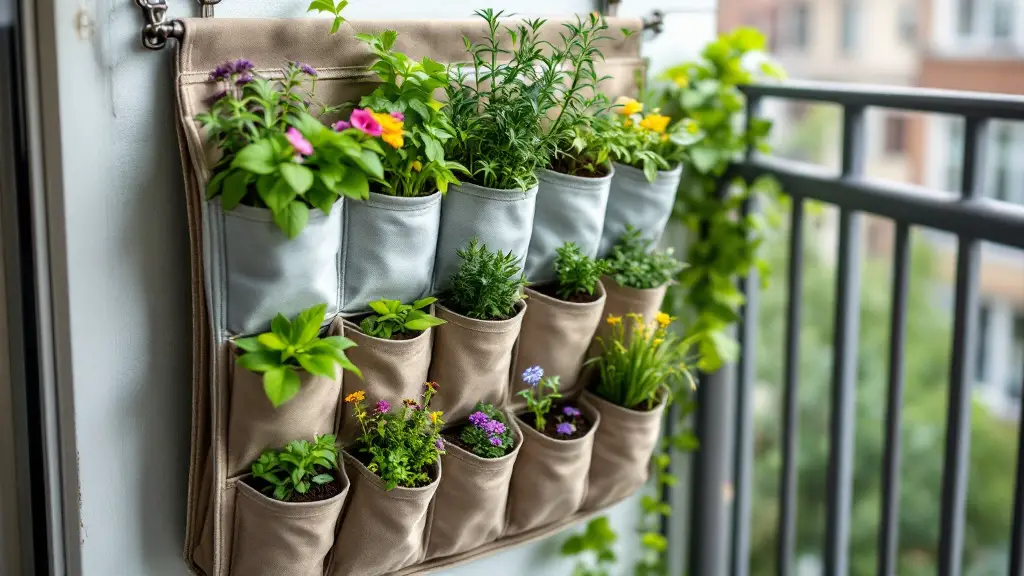
Repurposing Over-the-Door Shoe Organizers
An over-the-door shoe organizer can become a creative vertical garden. These organizers, made of fabric or plastic, have pockets perfect for planting. Hang them on walls, fences, or balcony railings to create a compact garden that is easy to install and maintain.
Ideal for Balconies or Patios
This method is great for renters or those seeking temporary gardening solutions. The organizer can be moved or removed without causing damage. It’s a versatile option that adapts to various small spaces.
Plant Suggestions
- Herbs: Thyme, oregano, and chives fit well in the pockets.
- Strawberries: They grow nicely and are easy to harvest.
- Flowers: Marigolds and nasturtiums add bright colors.
Setup Instructions
- Ensure Proper Drainage:
- If necessary, make small holes in the bottom of each pocket to allow excess water to escape.
- Fill Pockets with Soil:
- Use a good-quality potting mix suitable for the plants you choose.
- Planting:
- Place seeds or seedlings into each pocket, firming the soil around them.
- Mounting:
- Hang the organizer securely, making sure it can support the weight when filled.
Maintenance Tips
- Water regularly, keeping in mind that pockets may dry out quickly.
- Fertilize as needed to support plant growth.
- Rotate or reposition the organizer if sunlight conditions change.
Idea 5: Climbing Plants on Trellises and Arbors

Installing Trellises in Small Spaces
Trellises and arbors provide support for climbing plants, allowing them to grow vertically. Attach a trellis to a wall or use a freestanding one in a pot. This method adds height and visual interest without taking up much ground space.
Choosing Climbing Plants
- Flowering Vines: Clematis, morning glory, and jasmine offer beautiful blooms and fragrances.
- Edibles: Climbing beans, peas, and certain tomato varieties provide fresh produce.
- Evergreens: Ivy or climbing fig can create year-round greenery.
Creating Privacy Screens
Growing dense foliage on a trellis can serve as a natural privacy screen. This is especially useful on balconies or patios where you want to block views or reduce noise. It enhances privacy while adding beauty to your space.
Tips for Success
- Ensure your plants receive adequate sunlight for healthy growth.
- Use soft ties or clips to guide plants as they climb the trellis.
- Choose plants suitable for your climate and the specific conditions of your space.
- Regularly prune and train the plants to maintain the desired shape and size.
Idea 6: Stackable Planter Systems
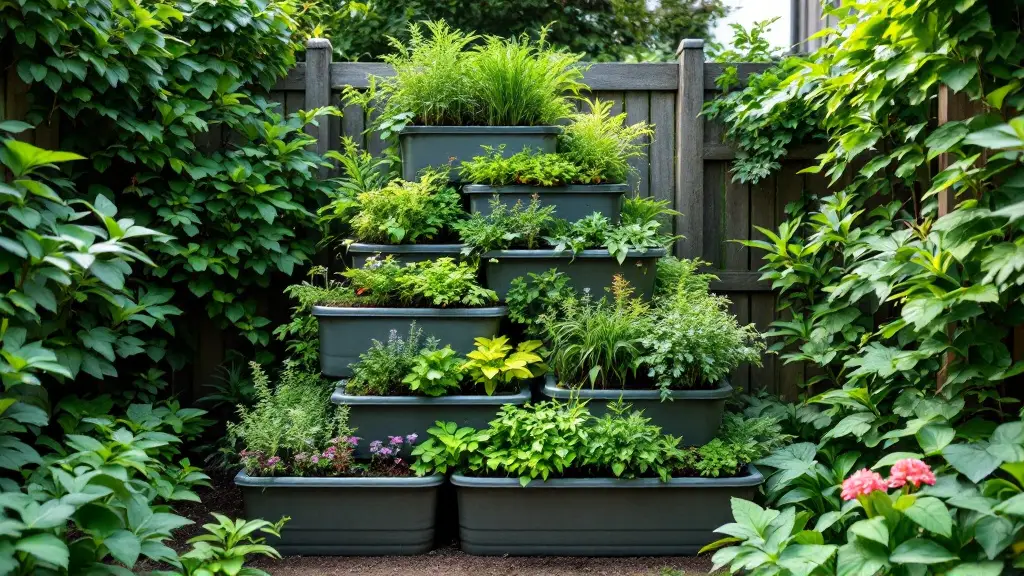
Overview of Stackable Planters
Stackable planters are designed to fit on top of each other, creating a vertical garden with multiple levels. Made from materials like plastic or terracotta, they are lightweight and come in various sizes and styles. These systems are perfect for small balconies, patios, or even indoor corners.
Maximizing Space
With a small footprint, stackable planters allow you to grow a variety of plants in a compact area. Each level can host different plants, maximizing your gardening potential without consuming precious floor space.
Examples and Where to Find Them
- Examples:
- Tiered strawberry planters designed specifically for growing strawberries in layers.
- Modular stacking pots that can be arranged in various configurations.
- Where to Buy:
- Garden centers, home improvement stores, and online retailers offer a range of options.
Planting Ideas
- Edibles: Lettuce, spinach, and herbs like basil and cilantro.
- Flowers: Pansies, impatiens, and begonias add color.
- Succulents: For a low-maintenance option, consider a succulent garden.
Maintenance Advice
- Water carefully, as upper levels may dry out faster than lower ones.
- Ensure even sunlight exposure by rotating the planter occasionally.
- Fertilize according to the needs of the plants you’ve chosen.
Idea 7: Vertical Garden Using Recycled Plastic Bottles
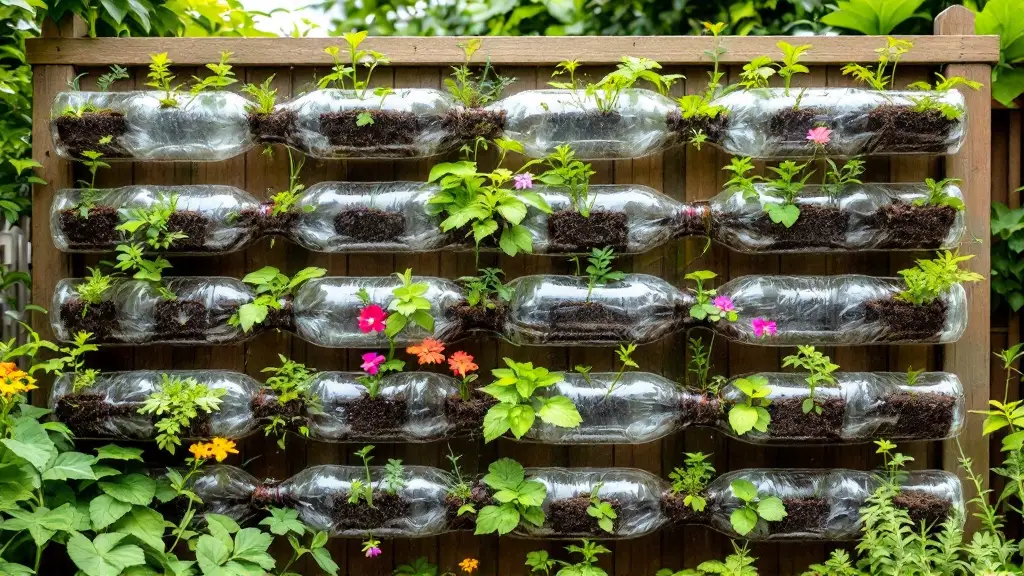
Creating an Eco-Friendly Vertical Garden
Using recycled plastic bottles to build a vertical garden is an environmentally friendly way to grow plants. This method reduces waste and provides an affordable option for gardening enthusiasts. By hanging bottles in a series, you create a cascading effect that is both functional and visually appealing.
Benefits for Small Spaces
This approach utilizes vertical space efficiently, making it suitable for balconies, patios, or even indoor areas with adequate light. It’s a cost-effective solution that allows for creativity in design.
DIY Instructions
- Materials Needed:
- Empty plastic bottles (1 or 2-liter sizes work well).
- Rope or wire, scissors or a knife, soil, seedlings.
- Preparation:
- Clean the bottles thoroughly.
- Cut a rectangular opening on the side for planting.
- Puncture small holes at the bottom for drainage.
- Assembly:
- Thread rope or wire through holes punched in the top and bottom of bottles.
- Stack bottles vertically, spacing them appropriately.
- Mounting:
- Hang the assembled structure against a wall or from a balcony railing.
- Planting:
- Fill each bottle with potting soil.
- Plant seeds or seedlings in the openings.
Suitable Plants
- Herbs: Basil, parsley, and chives grow well in small containers.
- Vegetables: Lettuce and spinach are suitable for this setup.
- Flowers: Marigolds and petunias add bright colors.
Maintenance Tips
- Water from the top, allowing gravity to assist with irrigation.
- Monitor moisture levels, as plastic can heat up and dry soil quickly.
- Secure the structure well to withstand wind if placed outdoors.
Environmental Impact
This method promotes recycling and reduces plastic waste. It encourages sustainable gardening practices and raises awareness about environmental responsibility.
Idea 8: Vertical Planter Boxes with Irrigation Systems
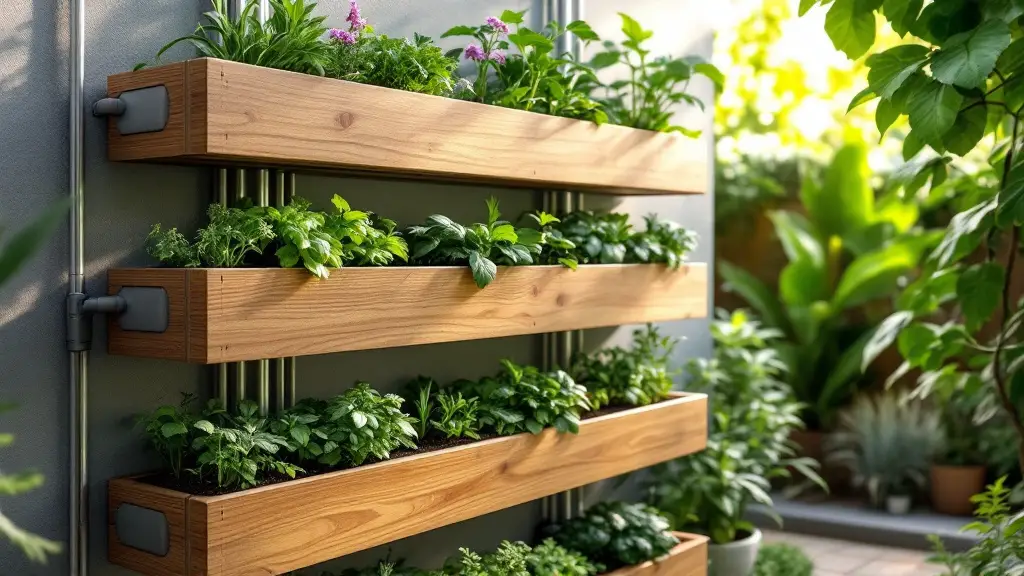
Installing Vertical Planter Boxes
Mounting planter boxes directly onto walls or fences creates a layered vertical garden. Using narrow boxes saves space and allows for a customizable arrangement to fit your wall dimensions. This setup can be tailored to suit both aesthetic preferences and functional needs.
Integrating Irrigation Systems
Incorporating drip irrigation or self-watering mechanisms ensures consistent moisture levels, reducing maintenance time. These systems can be as simple as a homemade drip line or as advanced as automated irrigation kits.
Benefits for Small Spaces
This method maximizes wall space and is ideal for busy individuals who need a low-maintenance garden. The integrated irrigation reduces the risk of overwatering or underwatering, helping plants thrive.
Plant Suggestions
- Edibles: Grow lettuce, radishes, or small root vegetables.
- Flowers: Geraniums, impatiens, and trailing lobelia work well.
- Herbs: Sage, rosemary, and thyme are good options.
Installation Tips
- Use durable materials suitable for outdoor exposure, like treated wood or metal.
- Securely fasten boxes to support the weight of soil and plants.
- Ensure proper drainage to prevent water damage to walls.
- Consider lining the boxes with landscape fabric to retain soil while allowing water to drain.
Idea 9: Pegboard Vertical Gardens
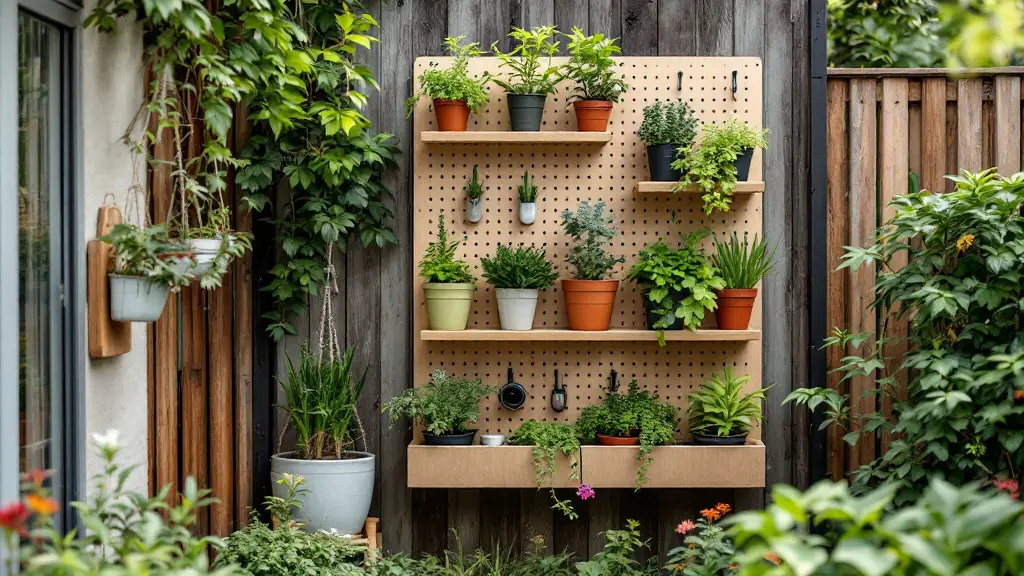
Using Pegboards as a Versatile Plant Display
A pegboard offers a flexible and stylish way to create a vertical garden. By mounting a wooden or metal pegboard on a wall, you can hang pots and planters using hooks and shelves. This setup allows for easy rearrangement and customization to suit your space and preferences.
Customizable and Adaptable Design
The pegboard system lets you change the arrangement of plants and accessories whenever you like. Add or remove elements to refresh the look or adapt to the changing needs of your plants.
Ideal for Indoor Spaces
This method is perfect for kitchens, living rooms, or offices where you want to add greenery without taking up floor space. It combines functionality with decorative appeal, enhancing the interior design.
DIY Instructions
- Materials Needed:
- Pegboard, mounting hardware, hooks, small shelves.
- Mount the Pegboard:
- Securely attach it to wall studs or use appropriate anchors to support the weight.
- Arrange Hooks and Shelves:
- Place them according to the size and weight of your planters.
- Add Plants and Accessories:
- Hang small pots, add shelves for larger plants, and include decorative items like photos or artwork.
Plant Suggestions
- Air Plants (Tillandsia): They require minimal soil and can be attached directly to the board.
- Small Potted Plants: Succulents, cacti, or herbs in lightweight containers.
- Trailing Plants: Pothos or string of pearls add a cascading effect.
Maintenance Tips
- Ensure pots are securely hung to prevent accidents.
- Use drip trays or liners to protect walls from moisture.
- Place the pegboard in a location that meets the light requirements of your plants.
Idea 10: Indoor Living Walls with Modular Systems

Overview of Modular Living Wall Systems
Modular living wall systems are pre-made panels designed for indoor use. They can be mounted on walls and often include built-in irrigation and lighting options. These systems transform a plain wall into a lush, green garden, enhancing the ambiance of your home.
Benefits for Small Indoor Spaces
Indoor living walls bring nature inside, improving air quality and creating a calming environment. They are space-efficient and can become a striking focal point in a room.
Product Recommendations
- Look for brands that offer user-friendly kits suitable for beginners.
- Systems that include automated irrigation and easy installation features are ideal.
- Consider options that allow for expansion or reconfiguration.
Suitable Plants
- Tropical Plants: Philodendrons, ferns, and peace lilies thrive indoors.
- Low-Light Tolerant Species: If natural light is limited, choose plants like snake plants or ZZ plants.
- Herbs and Edibles: Some systems support growing small edibles indoors.
Installation and Maintenance
Installation:
- Follow the manufacturer’s instructions carefully.
- Ensure the wall can support the weight of the system, considering both the structure and the moisture.
- Install any required irrigation and lighting components.
Maintenance:
- Regularly check the irrigation system to ensure proper function.
- Prune plants to maintain the desired appearance and prevent overgrowth.
- Monitor for pests or diseases and address them promptly.
Time to Start Creating
Encouragement to Start a Vertical Garden
Small spaces need not limit your gardening aspirations. With creativity and the right approach, you can cultivate a thriving vertical garden that suits your space and lifestyle. These ideas demonstrate the versatility and adaptability of vertical gardening, offering solutions for various needs and preferences.
There Are so Many Benefits
Vertical gardens enhance aesthetics, improve air quality, and provide opportunities to grow your own food or enjoy beautiful flowers. They promote sustainable living and make efficient use of limited space.
Choose an idea that resonates with you and embark on your own vertical gardening project. Share your creations with friends, family, or online communities to inspire others. Continue exploring resources and learning more about vertical gardening to expand your green space even further.
Final Thoughts
Transforming small spaces into green havens is both achievable and rewarding. With these ten inspiring vertical garden ideas, you can bring nature into your home in creative and practical ways. Whether you’re an experienced gardener or just starting out, there’s a vertical garden solution that’s perfect for you. So gather your materials, get planting, and watch your small space flourish with the beauty of vertical gardening.
